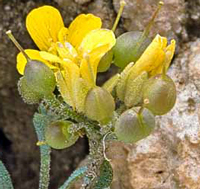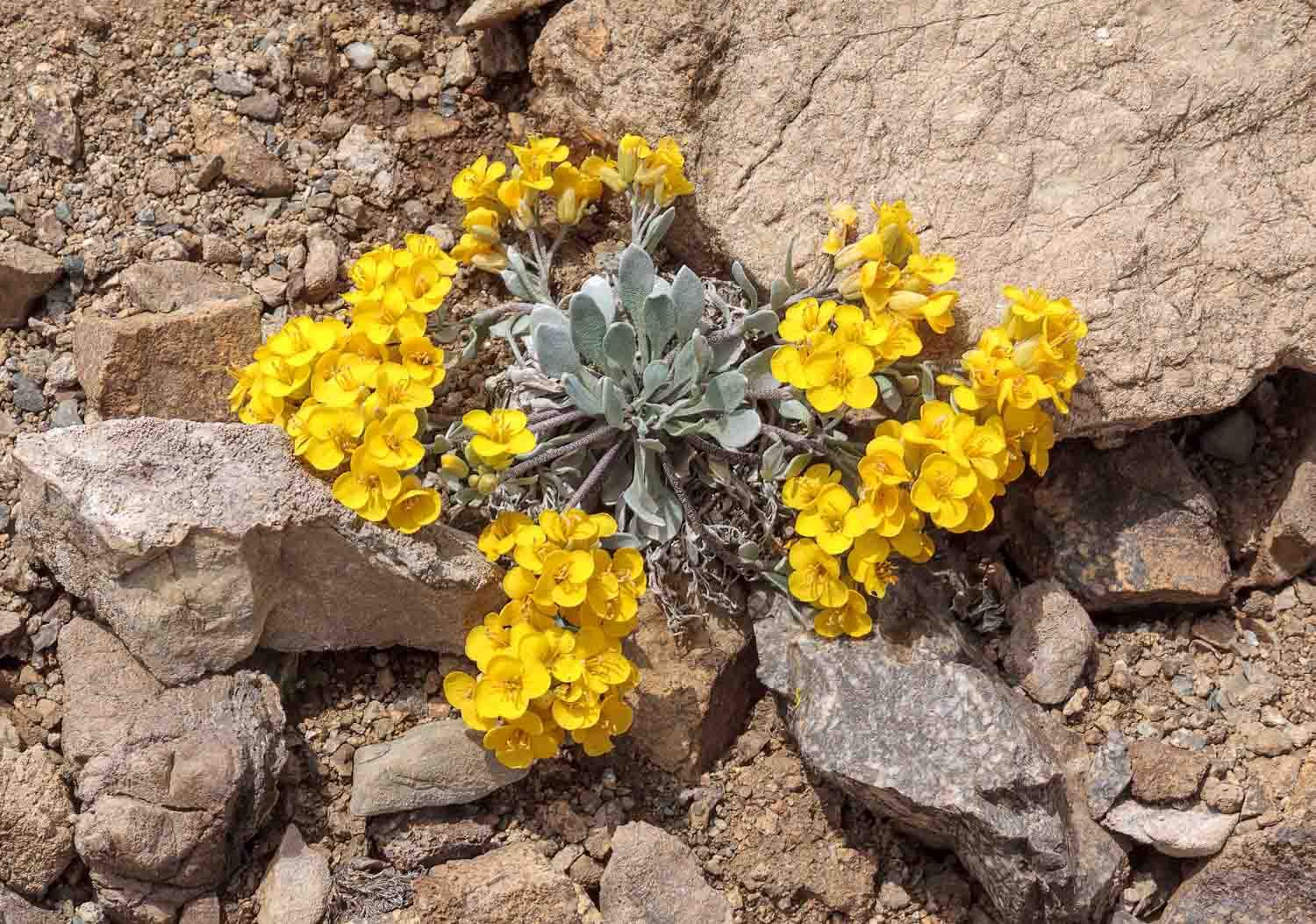Physaria Genus Photo Gallery
The Genus Physaria
The genus Physaria is one of the 44 genera in the mustard family (Brassicaceae) in Colorado. Species in this genus usually have a basal rosette of leaves, and yellow (rarely white or purple) flowers. The fruits, as in all species in the mustard family, are silicles, a dry fruit that separates at maturity into two or four segments called valves. The valves are globose to ovate to lanceolate and are often didymous. Didymous valves are described as looking like two balloons which are pressed together.
There are 24 species of Physaria in Colorado, and the fascinating thing about them is that ten are endemic to Colorado, five are critically imperiled (G1), six are imperiled (G2), and one is globally vulnerable (G3). All of the Colorado species have a geographic range that is clustered around the Rocky Mountain states.
For some reason, which we do not understand yet, Physaria, like some other Colorado genera are prone to speciation. As populations are separated geographically from one another they quickly adapt to local variations in microclimate and substrate and form a new species.
Two other genera in Colorado are also prone to quick speciation. There are 96 species of Astragalus, in Colorado, and of these 46 are considered rare: five are classified as critically imperiled (G1), 8 are considered imperiled (G2) and 17 are considered vulnerable (G3). Also, Eriogonum with a total of 40 Colorado species, has one critically imperiled, three imperiled and 8 vulnerable species.
Physaria favors very harsh environments on sedimentary or metamorphized sedimentary rocks. Substrates include shale, limestone, gypsum, chalk, and sand, often on hillsides. In addition, most of the species inhabit the driest parts of the state on the eastern plains, western semi-desert shrublands and foothills, avoiding more mesic areas in the montane and subalpine. As a result, the genus inhabits areas that are low in competition from other plants.
Two of the species, P. alpina and P. scrotoformis, however, occur in the alpine, which from the plant’s point of view is another form of desert.
Click on the photo to get started.
Scroll through using the left & right arrows.
Click the “i” to see information about the plant and the bottom down arrow remove the thumbnail carousel.
Click the arrow on the bottom-left to see a slide show.
Alpine Twinpod (Physaria alpina)
Alpine Twinpod (Physaria alpina), Mustard Family (Brassicaceae); G2S2 (Imperiled in Colorado Grows in rocky areas in the alpine on the East blooms June-July. This species is endemic to elevations over 3350 m in the high mountains of west central Colorado (the northeastern Gunnison Basin and the Mosquito Range). The total occupied habitat is about 187 acres, with are 6 principal occurrences two of which have not been observed in over 20 years. The primary threats are considered to be off road vehicle use and hiking. Photo by Steve O'Kane
Lesquerella or Physaria?
Lesquerella species in Colorado are another casualty of the new 21st century genetic research of our native plants as it has disappeared from our Colorado flora and completely in the genus Physaria. But unlike many other genetically based nomenclatural changes which have occurred in this millennium, both Weber and Wittman’s Colorado Flora and Ackerfields Flora of Colorado agree on this change.
But how did this occur? Asa Gray first described 22 species of Physaria in 1848. The species were distributed from North Dakota, south into Nebraska, Colorado and New Mexico and west to the Pacific states. Nineteen of these species occurred in Colorado.
Lesquerella, on the other hand, was first described by Sereno Watson, curator of Gray Herbarium at Harvard University 30 years later in 1888. He identified 33 species. In 1922, Edwin B. Payson, a Colorado botanist added 19 species, and in 1993, Reed Rollins, a professor at Harvard added 31 species to the list. Five species have been described after 1993. These plants were spread over a much wider geographic area in North America with one species found as far north as Northern Canada, Alaska, Greenland and Arctic Russia to the western United States, Mexico, and as far south as Southern South America.
Similarities and Differences
Secondly, in Physaria, the siliques were described to be compressed perpendicularly to the replum and in Lesquerella the siliques were compressed parallel to the replum (but several species violated this characteristic.
In addition to the two different morphological characteristics, when the fruits disperse, the valves and seeds disperse as a unit in Physaria, but the seeds are released freely in Lesquerella.
All other characteristics in the two genera were indistinguishable. Both genera had the same floral patterns, leaf morphology, growth habits, trichome morphology, seed coat and embryo type. All were growing on arid substrates with sparse vegetation. They were often the only species in their sites. They also had the same widespread geographic distribution in the dry western states and northern Mexico, with Physaria nestled in the middle of Lesquerella’s range. And finally, many of the species in each were rare.
In spite of the similarity of the species in the two genera, they remained separated until 2002. Botanists refused to pay attention to the lack of significant morphological differences because they were tied by tradition. Also they were adverse to placing the larger Lesquerella genus into the smaller Physaria genus. But by that time, genetic analysis showed that Physaria genetic characteristics nestled completely within the genetic variation of Lesquerella, and Physaria had evolved more than once from Lesquerella, so the case for combining the two genera was closed. In the end, all the Lesquerella species in North America were put in the Physaria genus because Physaria was described earlier by Asa Gray.



